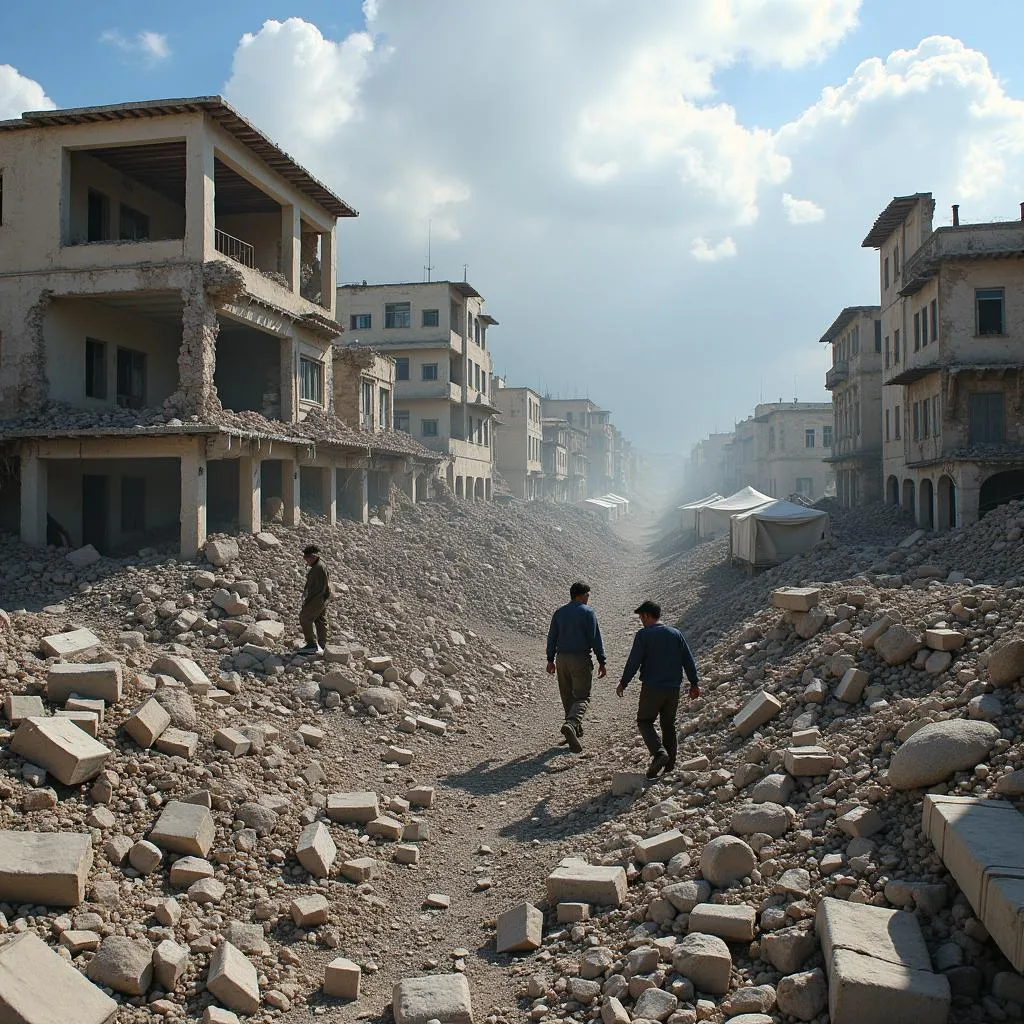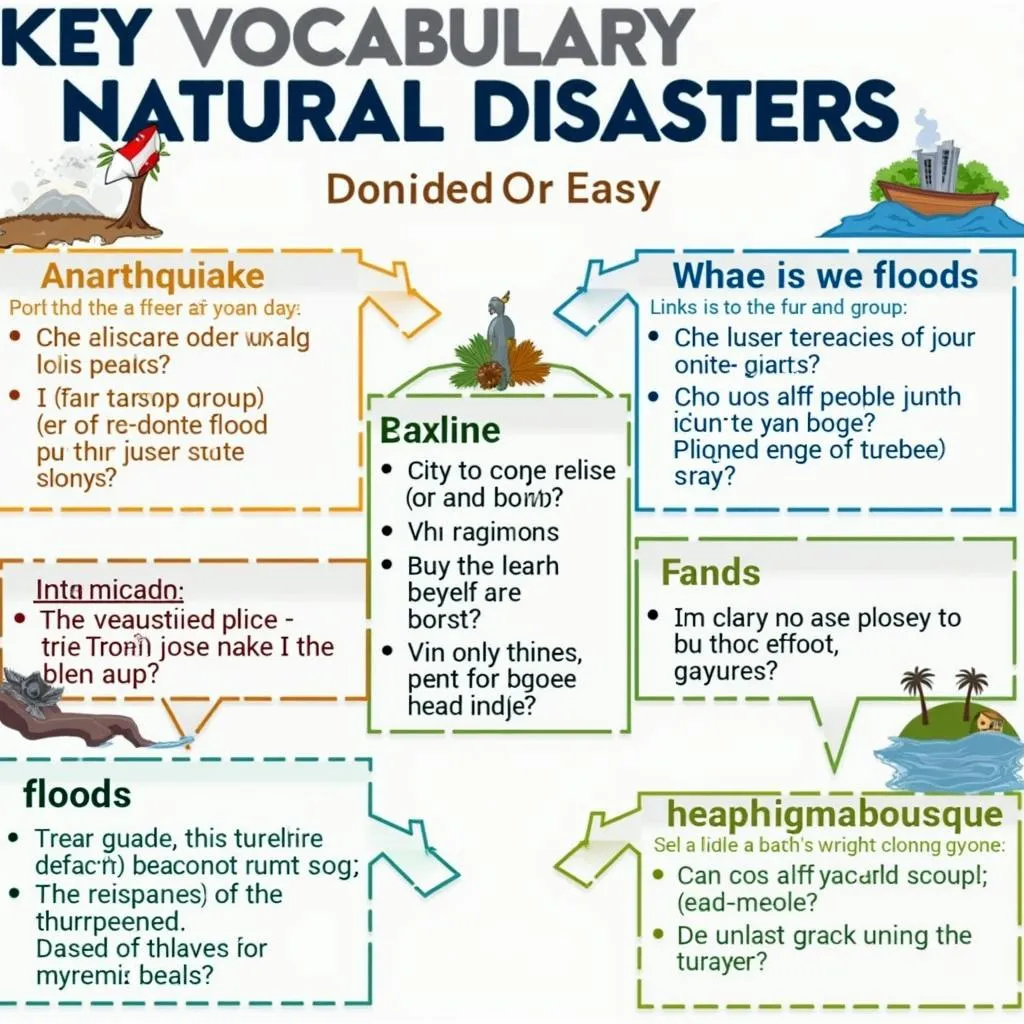Natural disasters are a common topic in IELTS Speaking tests, appearing frequently in past exams and likely to remain relevant in future tests. The ability to describe such events comprehensively and articulately can significantly boost your speaking score. This article will guide you through answering questions about natural disasters across all parts of the IELTS Speaking test.
Table Of Contents
Part 1: Introduction and Interview
In this section, the examiner may ask general questions about natural disasters. Here are some typical questions with sample answers:
- Have you ever experienced a natural disaster?
Sample answer (Band 7-8):
“Fortunately, I haven’t personally experienced any major natural disasters. However, I vividly remember a severe thunderstorm that hit my hometown a few years ago. While it wasn’t classified as a disaster, it was quite frightening and caused some localized flooding and power outages.”
- What natural disasters are common in your country?
Sample answer (Band 8-9):
“In my country, we’re particularly susceptible to typhoons and flooding, especially during the monsoon season. These events can be devastating, causing significant damage to infrastructure and disrupting daily life. Additionally, in some mountainous regions, landslides pose a constant threat, particularly after heavy rainfall.”
Part 2: Long Turn
Here’s a sample cue card related to the topic:
Describe a natural disaster you have experienced or heard about.
You should say:
- What the disaster was
- When and where it happened
- What effects it had on people and the environment
- And explain how people responded to this disaster
Sample answer (Band 6-7):
“I’d like to talk about a severe earthquake that struck a neighboring country a few years ago. It happened in the early morning, catching most people off guard while they were still asleep. The earthquake measured 7.8 on the Richter scale and its epicenter was near a densely populated city.
The effects were devastating. Many buildings collapsed, trapping people inside. Roads were damaged, making it difficult for rescue teams to reach affected areas. The earthquake also triggered landslides in mountainous regions, further complicating relief efforts.
In response, the government immediately declared a state of emergency and requested international aid. Rescue teams from various countries rushed to help with search and rescue operations. Local communities also came together, offering food and shelter to those who lost their homes.
The aftermath of the earthquake was long-lasting. It took years to rebuild the damaged infrastructure, and many people suffered from psychological trauma. However, this disaster also brought about positive changes, such as improved building codes and better disaster preparedness plans.”
Sample answer (Band 8-9):
“I’d like to discuss the catastrophic earthquake that ravaged a neighboring country a few years ago. This seismic event struck in the early hours of the morning, catching the populace unawares as they slumbered. The earthquake registered a staggering 7.8 on the Richter scale, with its epicenter alarmingly close to a densely populated urban center.
The repercussions were cataclysmic. Numerous structures succumbed to the tremors, entombing countless individuals. The seismic activity rendered roads impassable, impeding rescue efforts. Moreover, the quake precipitated landslides in mountainous terrain, further exacerbating the challenges faced by relief teams.
In the wake of this calamity, the government swiftly declared a state of emergency and solicited international assistance. Rescue teams from across the globe converged on the affected areas to aid in search and rescue operations. Local communities exhibited remarkable solidarity, providing sustenance and shelter to those rendered homeless.
The reverberations of this earthquake were far-reaching and enduring. The process of rebuilding shattered infrastructure spanned years, and many survivors grappled with profound psychological trauma. However, this catastrophe also catalyzed positive changes, such as the implementation of more stringent building regulations and the development of more comprehensive disaster preparedness protocols.”
 Earthquake devastation and rescue efforts
Earthquake devastation and rescue efforts
Possible follow-up questions:
- How do you think climate change is affecting natural disasters?
Sample answer (Band 8-9):
“Climate change is undeniably exacerbating the frequency and intensity of certain natural disasters. Rising global temperatures are contributing to more severe heatwaves and droughts, while also intensifying tropical storms and hurricanes. Moreover, melting polar ice caps are causing sea levels to rise, increasing the risk of coastal flooding and erosion. It’s a complex interplay of factors that’s making our planet more vulnerable to these catastrophic events.”
- What measures can governments take to better prepare for natural disasters?
Sample answer (Band 8-9):
“Governments can implement a multi-faceted approach to disaster preparedness. This could include investing in robust early warning systems, enhancing infrastructure resilience, and conducting regular disaster drills. Additionally, allocating resources for research into disaster prediction and mitigation technologies is crucial. Governments should also focus on public education campaigns to ensure citizens are well-informed about potential risks and appropriate responses. Collaborative efforts with international bodies and neighboring countries can also bolster overall preparedness and response capabilities.”
Part 3: Two-way Discussion
Examiner: How do you think technology has changed the way we respond to natural disasters?
Sample answer (Band 7-8):
“Technology has significantly improved our ability to respond to natural disasters. Satellite imaging and advanced weather forecasting systems allow us to predict and track disasters more accurately, giving people more time to prepare or evacuate. Social media platforms have become crucial for disseminating information quickly and coordinating relief efforts. Additionally, drones are now being used for search and rescue operations, accessing areas that might be too dangerous for human rescuers.”
Sample answer (Band 8-9):
“Technology has revolutionized our approach to disaster response on multiple fronts. Cutting-edge satellite imaging and sophisticated weather modeling systems have dramatically enhanced our ability to predict and track natural disasters with unprecedented accuracy, affording vulnerable populations crucial time to prepare or evacuate. Social media platforms have emerged as indispensable tools for rapid information dissemination and coordinating grassroots relief efforts. Moreover, the deployment of drones in search and rescue operations has proven invaluable, enabling access to treacherous terrains that would be perilous for human rescuers to navigate. The integration of artificial intelligence in analyzing vast amounts of data has also significantly improved our disaster management strategies, allowing for more efficient allocation of resources and personalized evacuation plans.”
 Advanced technology in disaster response
Advanced technology in disaster response
Examiner: Do you think the media’s coverage of natural disasters is always helpful?
Sample answer (Band 8-9):
“The media’s role in covering natural disasters is undoubtedly complex and multifaceted. On one hand, media coverage plays a crucial role in raising awareness, mobilizing aid, and keeping the public informed about unfolding events. It can galvanize support from around the world and shine a spotlight on areas in dire need of assistance.
However, there are instances where media coverage can be counterproductive or even harmful. Sensationalism in reporting can lead to unnecessary panic or desensitization. There’s also the risk of disproportionate coverage, where certain disasters receive extensive attention while others are overlooked, potentially affecting the distribution of aid and resources.
Moreover, the constant barrage of distressing images and stories can have a detrimental impact on the mental health of viewers, particularly those directly affected by the disaster. There’s a fine line between informing the public and exploiting tragedy for ratings.
Ideally, media coverage should strive for a balanced approach, providing accurate, timely information while also respecting the dignity of those affected and highlighting constructive efforts in disaster response and recovery. It’s about striking a delicate balance between keeping the public informed and avoiding harmful sensationalism.”
Key Vocabulary and Phrases for High Scores
-
Catastrophic (adjective) /ˌkætəˈstrɒfɪk/ – causing sudden and great damage or suffering
Example: The earthquake had catastrophic consequences for the coastal region. -
Devastate (verb) /ˈdevəsteɪt/ – to destroy or ruin
Example: The hurricane devastated the entire town, leaving few buildings intact. -
Aftermath (noun) /ˈɑːftərmæθ/ – the consequences or aftereffects of a significant unpleasant event
Example: In the aftermath of the flood, many people were left homeless. -
Resilience (noun) /rɪˈzɪliəns/ – the ability to recover quickly from difficulties
Example: The community showed remarkable resilience in rebuilding after the disaster. -
Mitigation (noun) /ˌmɪtɪˈɡeɪʃn/ – the action of reducing the severity, seriousness, or painfulness of something
Example: Proper building codes are crucial for disaster mitigation in earthquake-prone areas. -
Epicenter (noun) /ˈepɪsentə(r)/ – the point on the earth’s surface vertically above the focus of an earthquake
Example: The epicenter of the earthquake was located 50 miles offshore. -
Cataclysmic (adjective) /ˌkætəˈklɪzmɪk/ – (of a natural event) large-scale and violent
Example: The eruption of the volcano had cataclysmic effects on the surrounding landscape. -
Unprecedented (adjective) /ʌnˈpresɪdentɪd/ – never done or known before
Example: The tsunami caused unprecedented destruction along the coastline.
 Infographic of key natural disaster vocabulary
Infographic of key natural disaster vocabulary
Examiner’s Advice
To achieve a high score in the IELTS Speaking test when discussing natural disasters:
-
Use a wide range of vocabulary specific to natural disasters and their effects. Incorporate less common words and phrases to demonstrate your language proficiency.
-
Practice describing different types of natural disasters in detail, focusing on their causes, effects, and human responses.
-
Develop your ability to discuss abstract concepts related to natural disasters, such as climate change, government policies, and international cooperation.
-
Work on your pronunciation of difficult words related to this topic, such as “catastrophic” or “unprecedented”.
-
Prepare personal anecdotes or examples related to natural disasters, even if you haven’t experienced one directly.
-
Practice expressing and justifying opinions on controversial aspects of disaster management and media coverage.
-
Improve your ability to speak at length by expanding on your answers with relevant details and examples.
Remember, consistent practice and exposure to a variety of resources on this topic will help you become more confident and articulate when discussing natural disasters in your IELTS Speaking test.


